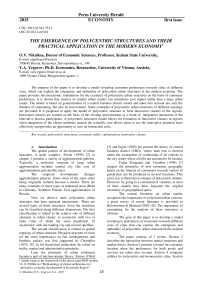The emergence ofpolycentric structures and their practical application in the modern economy
Автор: Nikulina O.V., Yegorov Y.A.
Журнал: Вестник Пермского университета. Серия: Экономика @economics-psu
Рубрика: Региональная и муниципальная экономика
Статья в выпуске: 1 (24), 2015 года.
Бесплатный доступ
The purpose of the paper is to develop a model revealing consumer preferences towards cities of different sizes, which can explain the emergence and optimality of polycentric urban structures in the modern economy. The paper provides microeconomic foundations for the existence of polycentric urban structures on the basis of consumer preferences. It is shown that clusters of smaller urban centers can sometimes give higher utility than a large urban center. The model is based on generalization of a central business district model and takes into account not only the distance of commuting, but also its convenience. Some examples of polycentric urban structures of different topology are provided. It is proposed to apply the model of polycentric structure to form innovative clusters in the regions. Innovation clusters are formed on the basis of the existing specialization as a result of integration interaction of the innovative process participants. A polycentric structures model allows for formation of innovative clusters in regions when integration of the cluster members around the scientific core allows them to use the innovative potential more effectively and provides an opportunity to save on transaction costs.
Polycentric structures, economic utility, optimization, innovative cluster
Короткий адрес: https://sciup.org/147201452
IDR: 147201452 | УДК: 330.101.542:332.1
Список литературы The emergence ofpolycentric structures and their practical application in the modern economy
- Nikulina O.V. Institutional approach to the formation of innovation capital of industrial enterprises in the economy clustering. National interests: priorities and security, 2012, no 46. pp. 19-26.
- Pertsik E.N. Cities. Geography of World Urbanization. Moscow: International Relations, 1999, 382 p.
- Alonso W. Location and land use. Cambridge. Harward University Press, 1964.
- Arthur W.B. Increasing returns and path dependency in the economy. Michigan Press, 1994, 201 p.
- Christaller W. Die zentralen Orte in Suddeutschland. Gustav Fischer, Jena, 1933.
- Fujita M. Urban Economic Theory: Land Use and City Size. Cambridge University Press, 1989, 367 p.
- Fujita M., Krugman P., Venables A. The Spatial economy. Cities, Regions and international trade. The MIT press, Cambridge, Massachusetts, 1999, 367 p.
- Kloosterman R., Musterd S. The Polycentric Urban Region: Towards a Research Agenda. Urban Studies, 2001, Vol. 38, no 4, pp.623634.
- Mascarilla-i-Miro O., Yegorov Y. Modelling Functional Area and Commuting Flows. Cuadernos de Economia, 2005, Vol. 28, pp. 39-56.
- Yegorov Y. Self-Organization of Spatial Structures. Santa Fe Institute WP, 1997, no 55, 18 p.
- Yegorov Y. Dacha Pricing in Russia: General Equilibrium Model of Location. CASE-CEU Working Paper, March 1999, no 18, Warsaw, 27 p.
- Yegorov Y. Elements of structural economics. Evolutionary and Institutional Economic Review, 2011, Vol. 7, no 2, pp. 233-259.
- Yegorov Y., Trullen J. Polycentric urban models. Unpublished manuscript, 2003, University of Barcelona.
- Saint Petersburg. Wikipedia, the free encyclopedia. Available at: http://en.wikipedia.org/wiki/Saint Petersburg (accessed 15.01.2015).
- Sochi. Wikipedia, the free encyclopedia. Available at: http://en.wikipedia.org/wiki/Sochi (accessed 15.01.2015).


